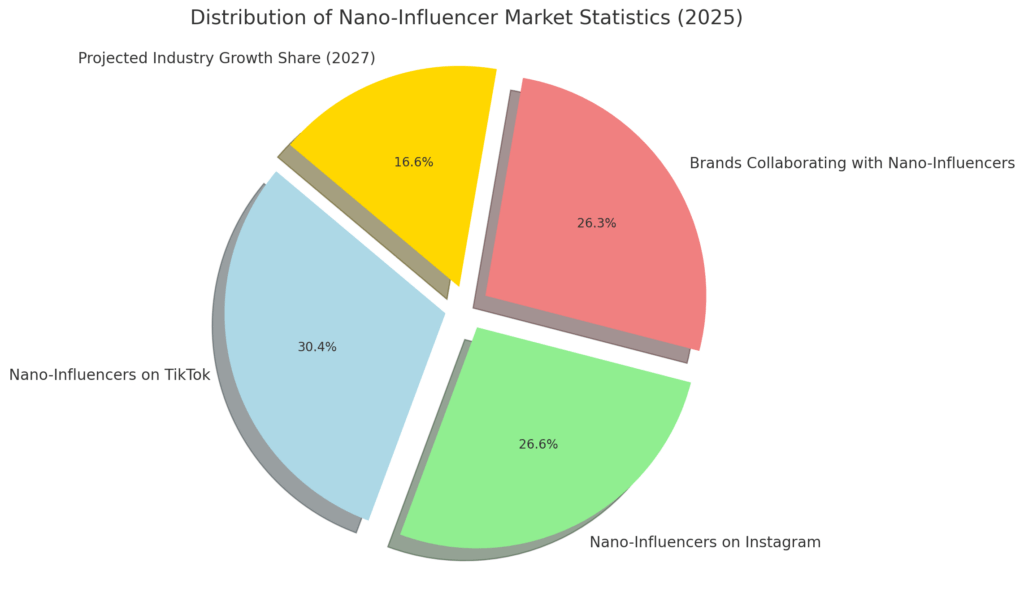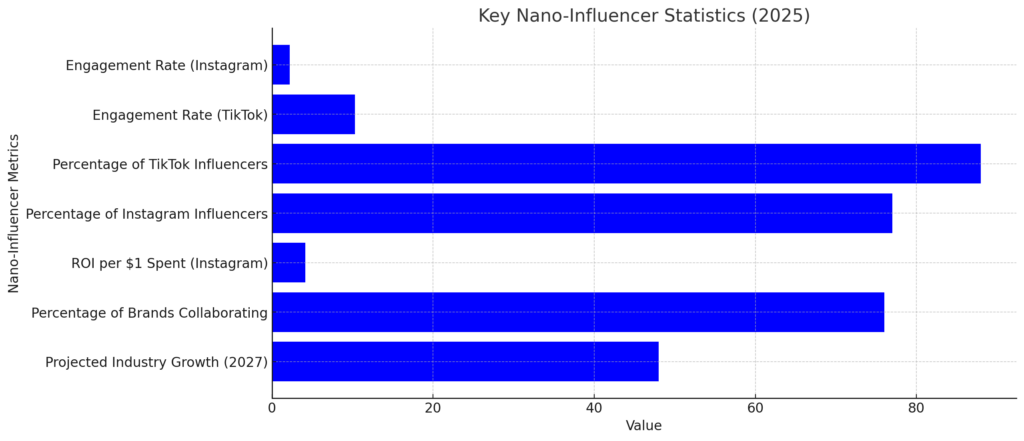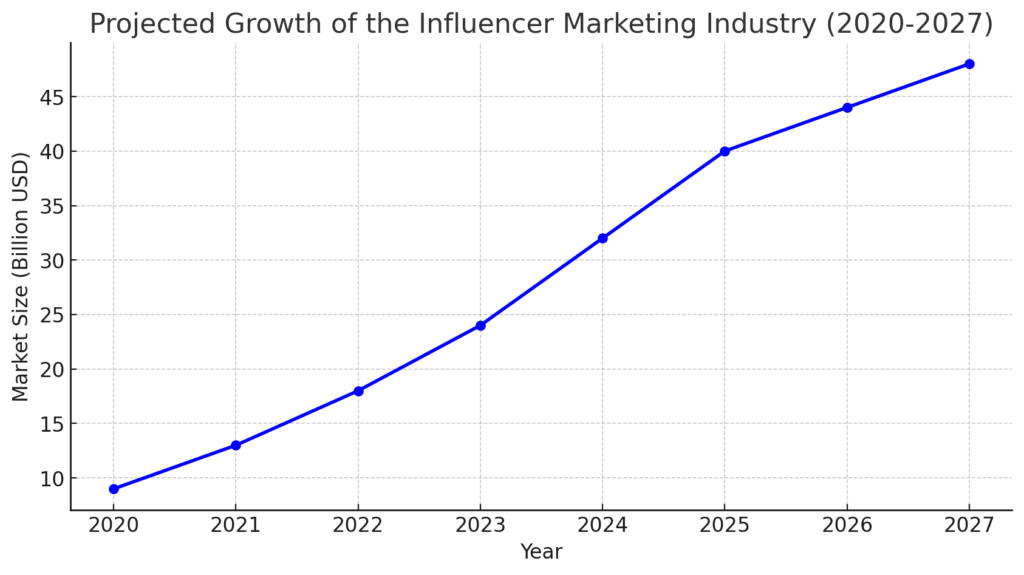
09 Mar BEST NANO-INFLUENCER STATISTICS 2025
Nano-influencers are reshaping the digital marketing landscape, offering brands an affordable yet highly engaging alternative to traditional influencers. With follower counts between 1,000 and 10,000, these creators foster deep connections with their audiences, making their recommendations more trustworthy. As social media platforms prioritize authenticity and engagement, nano-influencers have become essential players in brand campaigns. The rising demand for their content, coupled with evolving marketing strategies, signals a major shift toward decentralized influence. Looking at key statistics, it’s clear that nano-influencers are not just a passing trend but a growing force in digital advertising. From engagement rates to industry growth projections, these insights highlight why brands are investing in smaller creators. Amra and Elma provides a glimpse into the future of influencer marketing and how businesses can harness this trend for long-term success.
BEST NANO-INFLUENCER STATISTICS 2025 (Editor’s Choice)
Nano-influencers, typically defined as individuals with 1,000 to 10,000 followers, have become increasingly significant in the influencer marketing landscape. Here are ten key statistics highlighting their impact over time and projections for 2025:
1. High Engagement Rates: Nano-influencers achieve higher engagement rates compared to larger influencers. For instance, on Instagram, nano-influencers have an average engagement rate of 2.19%, surpassing mega-influencers who have over one million followers.
2. Dominant Presence on Platforms: A significant majority of influencers on platforms like TikTok and Instagram are nano-influencers. Approximately 88% of TikTok influencers and 77% of Instagram influencers have fewer than 10,000 followers.
3. Cost-Effectiveness: Brands find collaborations with nano-influencers to be more cost-effective. Nearly 50% of marketers consider nano-influencers as a budget-friendly option, allowing for authentic relationships with audiences without substantial financial investment.
4. Preferred by Brands: A considerable number of brands are partnering with nano-influencers. Approximately 76% of brands have collaborated with nano-influencers in the past year, indicating a preference for this tier due to their authenticity and engagement.
5. Projected Industry Growth: The influencer marketing industry is projected to grow significantly, reaching an estimated $48 billion by 2027. This growth underscores the increasing importance of influencers, including nano-influencers, in marketing strategies.
6. Influence on Purchasing Decisions: A substantial portion of consumers are influenced by nano-influencers. Approximately 63% of consumers are more likely to purchase a product recommended by a trusted influencer, highlighting the persuasive power of nano-influencers.
7. Content Creation Focus: The primary goal for many brands working with nano-influencers is to generate user-generated content (UGC). About 56% of businesses invest in influencer campaigns primarily to create UGC, with sales generation being a secondary objective.
8. Affordable Collaboration Rates: Nano-influencers typically charge between $10 and $100 per post, making them an affordable option for brands seeking authentic engagement without significant expenditure.
9. Higher Engagement on TikTok: On TikTok, nano-influencers have an average engagement rate of 10.3%, which is higher than the platform’s mega-influencers, who have an engagement rate of 7.1%.
10. Rising Demand: Brands are increasingly working with more nano and micro-influencers each year. There’s a 33% annual increase in collaborations with these smaller creators, reflecting their growing importance in marketing strategies.
These statistics highlight the growing significance of nano-influencers in the marketing landscape, emphasizing their high engagement rates, cost-effectiveness, and the authentic connections they foster with their audiences.

BEST NANO-INFLUENCER STATISTICS 2025 and Future Implications
BEST NANO-INFLUENCER STATISTICS 2025 #1. High Engagement Rates (2.19% for nano-influencers on Instagram)
Nano-influencers consistently achieve higher engagement rates than larger influencers, with Instagram data showing an average engagement of 2.19%. This suggests that audiences trust and interact with smaller creators more than those with massive followings. Since authenticity is a growing priority for consumers, brands will likely continue prioritizing nano-influencer collaborations for more organic interactions. Unlike celebrity endorsements, nano-influencers foster deeper connections with their followers, making their recommendations more persuasive. As social media algorithms increasingly favor engagement over reach, nano-influencers are poised to become even more valuable for visibility. Businesses looking for a cost-effective way to enhance brand loyalty should focus on long-term relationships with nano-influencers rather than one-off promotions. Moving forward, brands may shift marketing budgets from high-profile influencers to multiple smaller collaborations, maximizing authentic engagement.
BEST NANO-INFLUENCER STATISTICS 2025 #2. Dominant Presence on TikTok and Instagram (88% on TikTok, 77% on Instagram)
Nano-influencers dominate TikTok and Instagram, making up the vast majority of content creators on both platforms. This trend indicates that the influencer ecosystem is decentralizing, moving away from a few elite figures to a more diverse landscape of micro and nano-creators. With the rise of short-form video, nano-influencers hold a distinct advantage in reaching niche communities that respond to personalized, relatable content. As TikTok continues to disrupt the social media market, nano-influencers will play a crucial role in shaping trends and driving organic engagement. Brands that fail to recognize this shift may struggle to maintain relevance in digital spaces where authenticity matters more than production quality. The dominance of nano-influencers also suggests that brands will need to refine their influencer marketing strategies, focusing more on volume and niche targeting rather than broad audience reach. This change could lead to platforms introducing better monetization features for small creators, further solidifying their role in the digital economy.
BEST NANO-INFLUENCER STATISTICS 2025 #3. Cost-Effectiveness (50% of marketers see nano-influencers as budget-friendly)
Nano-influencers offer a cost-effective alternative for brands seeking engagement without the hefty price tags associated with celebrity endorsements. This affordability makes influencer marketing more accessible to small and medium-sized businesses, allowing them to compete with larger brands on social media. Since nano-influencers are more willing to collaborate in exchange for free products or modest compensation, brands can maximize their reach by working with multiple creators at once. The high ROI associated with nano-influencers means businesses are likely to allocate more budget to this segment in future campaigns. As competition grows, nano-influencers may become more strategic in pricing their services, potentially leading to a more structured industry standard for pricing. Platforms might also step in to facilitate better matchmaking between brands and influencers, ensuring fair compensation while maintaining affordability. Looking ahead, companies that invest in nano-influencers now could establish long-term partnerships that grow as these creators expand their followings.
BEST NANO-INFLUENCER STATISTICS 2025 #4. Preferred by Brands (76% of brands worked with nano-influencers last year)
The fact that 76% of brands collaborated with nano-influencers underscores their growing importance in marketing strategies. This trend suggests that marketers value authenticity over sheer follower count, as nano-influencers are seen as more trustworthy and relatable. The rise in demand also indicates that brands recognize the power of peer-to-peer recommendations in influencing consumer behavior. As influencer saturation increases, companies will likely continue diversifying their partnerships, opting for multiple nano-influencers rather than a few macro-influencers. With this growing demand, nano-influencers may gain more leverage in negotiations, leading to better compensation structures and contract terms. Brands that cultivate strong, long-term relationships with nano-influencers will likely benefit from sustained audience trust and loyalty. Moving forward, we may see a shift toward brands developing ambassador programs that prioritize ongoing nano-influencer collaborations over single sponsored posts.
BEST NANO-INFLUENCER STATISTICS 2025 #5. Projected Industry Growth ($48 billion influencer market by 2027)
The influencer marketing industry’s projected growth to $48 billion by 2027 signals a massive expansion in digital marketing investments. This growth will likely result in more sophisticated influencer marketing tools, making it easier for brands to track performance metrics and ensure effective collaborations. With nano-influencers playing a key role in this expansion, platforms may develop more features tailored to small creators, such as automated brand matchmaking and built-in monetization tools. As companies continue shifting budgets from traditional advertising to influencer partnerships, we can expect nano-influencers to receive a larger share of these funds. The rise of AI-driven influencer marketing tools may also help brands identify ideal nano-influencers for campaigns based on audience insights. Increased competition among brands to secure authentic influencers could lead to higher earning potential for nano-creators. In the long run, influencer marketing may become an essential part of nearly every digital advertising strategy, particularly for brands targeting Gen Z and millennial consumers.

BEST NANO-INFLUENCER STATISTICS 2025 #6. Influence on Purchasing Decisions (63% of consumers trust influencer recommendations)
The fact that 63% of consumers are more likely to purchase based on influencer recommendations highlights the power of social proof. Nano-influencers, who maintain strong relationships with their followers, benefit from this trust at a higher rate than traditional advertisements. Consumers often view nano-influencers as peers rather than paid endorsers, making their product suggestions feel more genuine. As traditional advertising loses effectiveness, brands will increasingly depend on nano-influencers to shape consumer preferences. This shift may encourage companies to move away from polished, scripted endorsements toward raw, authentic content that aligns with everyday consumer experiences. With the continued rise of social commerce, nano-influencers may become direct sales drivers, influencing purchasing decisions in real-time through platforms like TikTok Shop and Instagram Checkout. Brands that embrace influencer-led marketing strategies early will likely see stronger conversions and deeper audience trust.
BEST NANO-INFLUENCER STATISTICS 2025 #7. Content Creation Focus (56% of brands use nano-influencers for UGC)
More than half of brands prioritize user-generated content (UGC) from nano-influencers, showing a clear preference for organic, community-driven marketing. This focus suggests that brands value nano-influencers not just for their audience reach but for their ability to produce authentic, relatable content. UGC campaigns tend to perform better because they blend seamlessly into social media feeds, avoiding the disruptive feel of traditional ads. As social media platforms continue adjusting algorithms to prioritize content over promotional posts, UGC from nano-influencers will become an even more valuable asset. This growing demand for organic content may lead to specialized tools for brands to repurpose influencer-created media across multiple channels. Future collaborations might extend beyond one-time posts, with brands securing long-term content licensing deals with nano-influencers. The shift toward influencer-led UGC will likely redefine how brands approach content marketing, moving away from in-house production teams to distributed, influencer-generated material.
BEST NANO-INFLUENCER STATISTICS 2025 #8. Affordable Collaboration Rates ($10-$100 per post)
With nano-influencer rates ranging from $10 to $100 per post, they present an attractive option for brands with limited budgets. This affordability allows brands to experiment with multiple creators, testing different messaging strategies and audience segments. The low entry cost also means startups and small businesses can leverage influencer marketing without significant financial risk. As nano-influencers continue proving their value, we may see incremental increases in their rates, particularly for those with highly engaged audiences. Some brands may even start offering long-term retainers to lock in nano-influencers before their prices rise. Looking ahead, platforms might introduce standardized pricing tiers to help brands navigate influencer negotiations more efficiently. Despite potential rate increases, nano-influencer marketing is expected to remain one of the most cost-effective digital advertising strategies for years to come.

BEST NANO-INFLUENCER STATISTICS 2025 #9. Higher Engagement on TikTok (10.3% engagement rate for nano-influencers)
Nano-influencers on TikTok achieve an impressive engagement rate of 10.3%, significantly higher than mega-influencers. This indicates that audiences are more likely to interact with content from smaller creators, particularly on platforms that prioritize authenticity. As TikTok continues shaping digital culture, brands must adjust their strategies to include more nano-influencers in their campaigns. The platform’s algorithm favors engagement-heavy content, making nano-influencers a natural fit for brands looking to boost visibility. Future marketing strategies may focus on long-term collaborations where nano-influencers create ongoing TikTok series rather than one-off sponsored posts. With TikTok becoming a dominant force in e-commerce, nano-influencers could play a key role in driving direct sales. Businesses that fail to integrate TikTok nano-influencer campaigns risk losing traction in an increasingly video-driven digital landscape.
BEST NANO-INFLUENCER STATISTICS 2025 #10. Rising Demand (33% increase in nano-influencer collaborations)
A 33% annual increase in nano-influencer collaborations indicates that brands recognize their growing value. This trend suggests that businesses are moving away from traditional celebrity endorsements in favor of relatable, grassroots marketing. As nano-influencer demand rises, brands may start forming exclusive partnerships to secure long-term collaborations. Companies that build strong relationships with nano-influencers early may benefit from sustained brand loyalty and organic word-of-mouth marketing. Future developments could include agency models specifically catering to nano-influencers, helping them navigate brand deals more efficiently. Increased demand may also lead to more transparent pricing structures and contractual agreements for small creators. The continued expansion of nano-influencer marketing signals a shift toward a more decentralized and community-driven advertising ecosystem.
The Future of Nano-Influencer Marketing
Nano-influencers are no longer just an emerging trend—they are a fundamental part of modern digital marketing. Their high engagement rates, affordability, and authenticity make them a powerful asset for brands looking to connect with consumers in meaningful ways. As influencer marketing continues its rapid expansion toward a projected $48 billion industry, nano-influencers will play an even bigger role in shaping consumer behavior. The growing preference for user-generated content, combined with platform algorithms favoring engagement over reach, means that smaller creators will continue to gain traction. Brands that recognize this shift and invest early in nano-influencer partnerships will benefit from stronger audience trust and higher conversion rates. Looking ahead, we can expect more structured collaborations, improved monetization opportunities for small creators, and deeper integrations between influencer marketing and e-commerce. Companies that adapt to this evolving landscape will be best positioned to thrive in the influencer-driven economy of the future.
Sources:
- https://thesocialshepherd.com/blog/influencer-marketing-statistics
- https://sproutsocial.com/insights/influencer-marketing-statistics
- https://www.kolsquare.com/en/blog/the-rise-of-nano-influencers
- https://www.influencerintelligence.com/blog/TT1/new-report-the-rise-of-nano-influencers
- https://www.dash.app/blog/influencer-marketing-statistics
- https://www.dash.app/blog/influencer-marketing-statistics
- https://www.sixthcitymarketing.com/influencer-marketing-statistics
- https://www.sixthcitymarketing.com/influencer-marketing-statistics
- https://sproutsocial.com/insights/influencer-marketing-statistics
- https://www.clearvoice.com/resources/influencer-marketing-statistics

